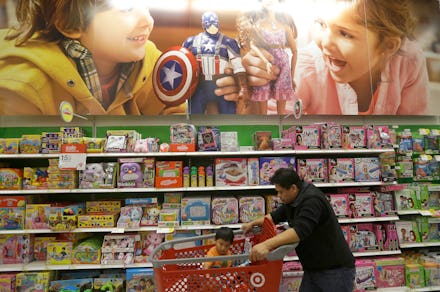Being a Woman Costs a Lot More Than Being a Man, Says New Study

This Christmas season, you may have wanted to get your male family member — let's call him Johnny — a scooter. Perhaps you wanted to do the same for a female family member — let's call her Susie. If you bought both, that might come out to about $75 — but not because it's an even split at $37.50 a piece. The red scooter, pictured below, marketed to boys, goes for $25, while the pink sparkle scooter is $50. According to the New York City Department of Consumer Affairs' new study, "From the Cradle to the Cane: The Cost of Being a Female Consumer," the reality of gender pricing will follow a girl or woman throughout her entire life.
To find out the difference in pricing, DCA analyzed 794 products in 24 different stores across five industries: toys and accessories, children's clothing, adult clothing, personal hygiene products and home health care products for seniors. The range of industries shows the lifelong shadow of gender pricing. Overall, out of the 397 comparisons made — totaling 794 products — women ended up paying more 42% of the time, while men paid more only 18% of the time. The rest of the time, they were equal.
When it came to toys and accessories, girls' products cost 7% more. Girls' clothing cost 4% more than boys' clothing and women's clothing cost 8% more than men's. The highest discrepancy was in women's personal hygiene products, which cost 13 percent more than men's, while senior health products for women cost 8% more than products for elderly men. Here are just a few examples the study pointed out:
Whether regular price or discounted, these uniform shirts are over $2 apart.
Similar jeans at Levi's will run women $20 more than they would for men.
Abercrombie & Fitch may be working for better representation by hiring an Indian Sikh model to be its new face, but they're still charging women $10 more for the same branded shirts. After a steep discount for this men's graphic tee, women actually paid $28 more for the same shirt.
Some of the most egregious price violations came from the category with the biggest percentage difference — personal care products. Women paid $0.70 more for two-in-one shampoo than men did for three-in-one shampoo.
And the price gouging doesn't end once you grow up, either. Senior women have to pay more for their personal care products, including support braces, which ran senior women $27 as opposed to $23 for senior men. Even bladder control pads had a sneaky pricing problem: Men got 13 more pads for the same price.
The study did acknowledge that men's and women's products often differ in construction, branding and ingredients and therefore chose products that mirrored each other as closely as possible in those categories. The head of the department said the study underscores a big civil rights problem for women.
"The most basic consumer right is one and the same with the most basic civil right – you should not be treated differently based on your gender and that includes how much you're charged," said Department of Consumer Affairs Commissioner Julie Menin in a press release. "In New York City, businesses can set their own prices but it is DCA's job to make sure that a consumer knows what that price is."
Menin said she hopes the study helps people make educated shopping choices, but that it also helps bring about change. "We also encourage all New Yorkers to join us in calling on retailers to change their pricing practices," she said.
You can read the full report here and you can also watch Mic's episode of Flip the Script on the #PinkTax, the amount women pay over a lifetime just for being a woman, below.